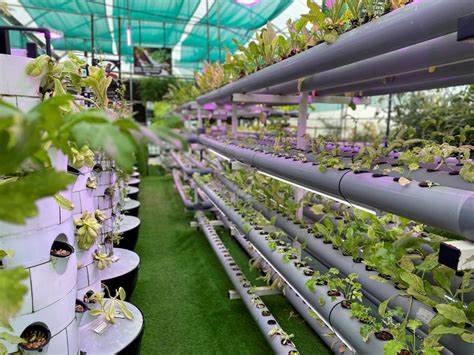
Vertical Farming: Maximizing Sustainability and Efficiency for the Future
Introduction
Vertical farming revolutionizes the traditional concept of agriculture by utilizing innovative techniques to grow crops in vertical layers, rather than on vast expanses of land. This article delves into the various aspects of vertical farming, highlighting its relevance and importance in achieving sustainability goals.
Historical Background
The history of vertical farming dates back to the Hanging Gardens of Babylon, showcasing humanity’s early attempts to cultivate plants in a vertical structure. Over time, significant milestones and developments propelled vertical farming to its current state of prominence.
Key Concepts and Definitions
Vertical farming can be defined as the practice of growing crops in vertically stacked layers, utilizing controlled environments and advanced technologies. Sustainability is a core principle of vertical farming, encompassing eco-friendly practices and resource conservation. Key terms such as hydroponics, aeroponics, and aquaponics play integral roles in this innovative farming method.
Efficient Use of Space
Maximized land use
Vertical farming optimizes land use by utilizing vertical space, enabling multiple layers of crops to be grown in a compact area. This innovative approach allows for higher yields per square foot compared to traditional farming methods, leading to increased food production.
Potential for urban farming and reduced transportation costs
Vertical farming has the potential to bring agriculture closer to urban areas, minimizing the need for long-distance transportation of produce. By establishing vertical farms in urban centers, fresh and nutritious food can be readily available, reducing carbon emissions associated with transportation.
Benefits of utilizing abandoned or underutilized buildings
Abandoned or underutilized buildings can be repurposed for vertical farming, breathing new life into derelict structures. Vertical farms can transform these spaces into productive hubs, creating employment opportunities and revitalizing communities.
Reduced Environmental Impact
Conservation of water resources through closed-loop systems
Vertical farming employs closed-loop systems, significantly reducing water usage compared to traditional farming. By recirculating and reusing water, vertical farms minimize water waste and alleviate the strain on dwindling water supplies.
Reduction in pesticide and fertilizer use through controlled environments
Controlled environments in vertical farming eliminate the need for excessive pesticide and fertilizer use. With precise control over lighting, temperature, and nutrient levels, crops can thrive without the need for harmful chemicals, resulting in safer and healthier produce.
Potential for carbon footprint reduction in food production
Vertical farming has the potential to greatly reduce the carbon footprint associated with food production. By minimizing transportation distances and utilizing energy-efficient technologies, vertical farms can significantly decrease greenhouse gas emissions.
Current Trends or Developments
Recent advancements in vertical farming technology
Recent advancements in vertical farming technology have led to increased efficiency and productivity. Innovations such as automated systems, artificial intelligence, and vertical farming robots have revolutionized the industry, making it more sustainable and economically viable.
Research findings related to sustainability benefits
Extensive research has been conducted to demonstrate the sustainability benefits of vertical farming. Studies have shown that vertical farms use significantly less water, land, and energy compared to traditional agriculture, making them a promising solution to global food security challenges.
Integration of renewable energy sources in vertical farming systems
The integration of renewable energy sources, such as solar panels and wind turbines, in vertical farming systems further enhances their sustainability. By harnessing clean energy, vertical farms can reduce their reliance on non-renewable resources and minimize environmental impact.
Challenges or Controversies
Potential challenges in scaling up vertical farming systems
Scaling up vertical farming systems presents challenges such as high initial investment costs, technical complexities, and logistical hurdles. However, ongoing advancements in technology and increasing demand for sustainable agriculture solutions are gradually overcoming these obstacles.
Economic viability and cost-effectiveness of vertical farming
The economic viability and cost-effectiveness of vertical farming are subjects of debate. While initial costs may be higher compared to traditional farming, the long-term benefits, including higher yields, reduced resource consumption, and potential savings in transportation costs, make vertical farming a promising investment.
Differing viewpoints on the overall sustainability of vertical farming
Differing viewpoints exist regarding the overall sustainability of vertical farming. While proponents highlight its potential to address food security, reduce environmental impact, and enhance resource efficiency, skeptics raise concerns about the scalability, energy requirements, and long-term environmental consequences of this farming method.
Future Outlook
Potential growth and expansion of vertical farming
The future of vertical farming looks promising, with projections indicating substantial growth and expansion. As technology continues to advance and awareness of sustainability increases, vertical farming is expected to play a significant role in meeting the growing demand for food in a sustainable manner.
Role of vertical farming in achieving sustainable agriculture goals
Vertical farming holds immense potential in achieving sustainable agriculture goals. By minimizing resource consumption, reducing environmental impact, and enhancing food security, this innovative farming method aligns with the global agenda of creating a more sustainable and resilient food system.
Potential advancements and innovations in the field
Anticipated advancements and innovations in vertical farming include the integration of advanced sensors and data analytics, vertical farming in outer space or extreme environments, and the adoption of circular economy principles to further enhance sustainability.
Conclusion
In conclusion, vertical farming offers a sustainable and efficient solution to address the challenges faced by traditional agriculture. By maximizing space usage, reducing environmental impact, and ensuring year-round production, this innovative farming method has the potential to revolutionize the way we grow food.
References
“Vertical Farming: From Concept to Reality” by Despommier, D. (2010)
“The Potential of Vertical Farming: A Review” by Qiu, R. et al. (2019)
“Sustainable Vertical Urban Food Production” by Ochoa, O. E. et al. (2016)